Sight Alignment and Sight Picture Means Hitting Your Target

Sight Alignment and Sight Picture Means Hitting Your Target – NRA Women.com
By correcting your sight alignment and sight picture, you can place your bullet where you intend!
You head to the gun range for a day of shooting. You have your handgun. You have your targets. What else could you want? How about putting your shots where you want them to go on your target? This is done by achieving proper sight alignment and proper sight picture. When these two things are done correctly and at the same time, you are properly aiming.
So what is proper sight alignment and sight picture? Sight alignment is the relationship of the front sight to the rear sight. Sight picture is the relationship of your proper sight alignment to your intended target. In other words, are your properly aligned sights aimed at the point on your target you want your bullet to hit?
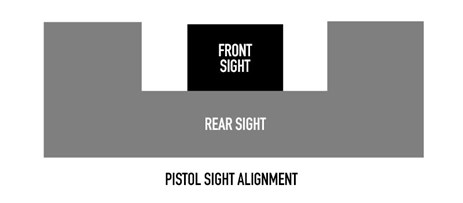
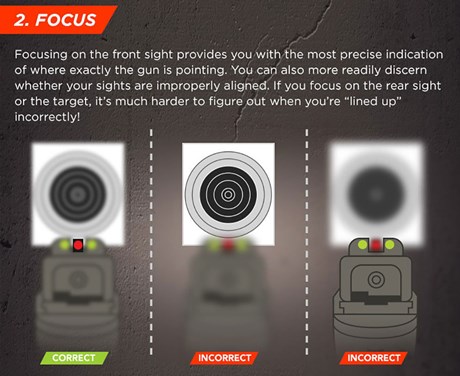
You cannot obtain the proper sight alignment and sight picture without understanding what type of sights you have and how to make adjustments, so you hit where you are aiming. Handguns have just as many options for sighting systems as rifles. Revolvers and semi-automatic pistols usually come with iron sights, also known as open sights. Most handguns are shot with this type of sight. To a lesser extent, some revolvers can be fitted with a telescopic sight, and some pistols can be fitted with electronic sighting systems.
The iron sight that is most found on handguns are Patridge sights. Patridge sights consist of a front sight and a rear sight. The front sight is located on top of the barrel or slide toward the front of the barrel, near the muzzle. The front sight is usually a post that has a squared-off top. The rear sight is located near the front of the cylinder or back of the slide. The rear sight is shaped like a squared-off “U” or a rectangle that is missing the top bar.
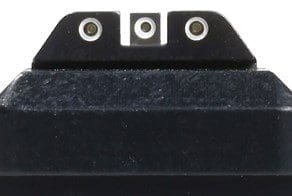
To obtain a proper sight alignment, the front sight or post is centered inside the rear sight. The top of the post should be even with the top of the rear sight. You will notice that the front sight does not completely fill in the rear sight. This is why the front sight must be centered in the rear sight. The easiest way to remember where the front sight goes in the rear sight is–Equal Light, Equal Height.
After you acquire the proper sight alignment, you must acquire a proper sight picture. First, to acquire the proper sight picture, you must know what to focus on. Since your eyes can only focus on one thing at a time, you should always focus on the front sight. The shooter should keep both eyes open, if possible. This reduces eye strain and allows the shooter to maintain depth perception. That means everything else in your sight picture will be slightly out of focus. You still should be able to make out what you are shooting at!
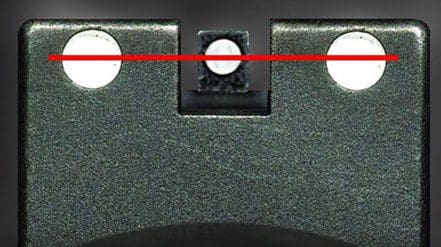
There are various styles of Patridge sights. Regardless of the type, the front and rear sight are aligned the same way. The most popular is a three-dot sight. The dots are usually glow-in-the-dark with one being on the front sight and the other two placed on the uprights of the rear sight. This way, when the three dots are aligned, you have a proper sight alignment.
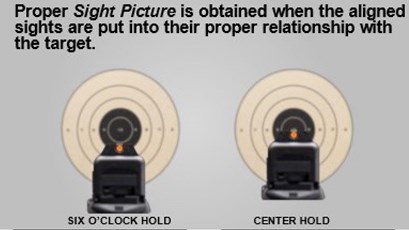
There are two ways to acquire the proper sight picture. There is the “six o’clock hold” and the “center hold.” The six o’clock hold is performed by aligning the front and rear sight while at the same time being able to see the whole target area. For example, the lined-up front and rear sights are below the area you want the bullet to impact. The more common hold is the center hold. When using the center hold, the lined-up front and rear sights cover where you want the bullet to impact. For example, the top edge of the front sight is where the bullet will impact.
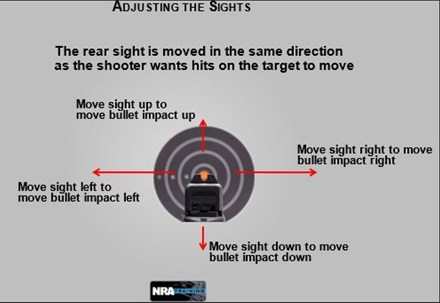
If you do everything right, but your bullet is not impacting the target where you want it to, you may need to adjust the rear sight On most handguns, the rear sight can be adjusted to move the point of impact. Remember, if you need to adjust the point of impact, move the rear sight in the direction you want the impact of the bullet to move. In other words, if your bullets are striking to the right of where you want them to, move the rear sight in the direction you want the bullets to move. In this example, if your bullets are hitting to the right of your target, move the rear sight to the left.
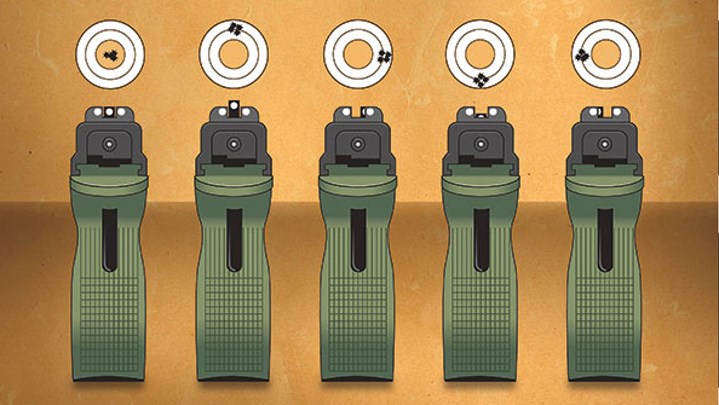
Still are not hitting where you want the bullet to impact? There are four errors you could be making when you are aligning the front and rear sight.
- If your shots are hitting to the left: Your front sight is too far to the left in the rear sight.
- If your shots are hitting to the right: Your front sight is too far to the right in the rear sight.
- If your shots are hitting too high: Your front sight is positioned too high in the rear sight.
- If your shots are hitting too low: Your front sight is positioned too low in the rear sight.
Remember, sight alignment is more critical than sight picture.
By correcting your sight alignment and sight picture, you can place your bullet where you want it to go. As an NRA Pistol Instructor, it is very rewarding for me to see my students start to self-analyze and then self-correct. When you can recognize why your bullet did not hit where you wanted it to impact and then identify what you did wrong, you are on your way to becoming a proficient shooter.
